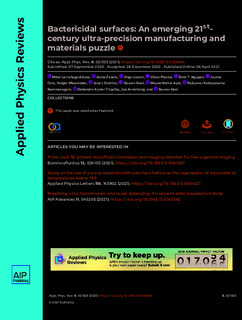Izenburua
Bactericidal Surfaces: An Emerging 21st Century Ultra-Precision Manufacturing and Materials PuzzleEgilea (beste erakunde batekoa)
Beste instituzio
Cranfield University (UK)Milton Keynes University Hospital
Eurecat Centre Tecnològic de Catalunya
Fraunhofer Institute for Production Technology (IPT)
UPV/EHU
Ikerbasque
London South Bank University
Cardiff University (UK)
All India Institute of Medical Science Rishikesh
Shiv Nadar University (India)
Bertsioa
Bertsio argitaratua
Eskubideak
© 2021 Author(s)Sarbidea
Sarbide irekiaArgitaratzailearen bertsioa
https://doi.org/10.1063/5.0028844Non argitaratua
Applied Physics Reviews Vol. 8. N. artículo 021303, 2021Argitaratzailea
AIP PublishingLaburpena
Progress made by materials scientists in recent years has greatly helped the field of ultra-precision manufacturing. Ranging from healthcare to electronics components, phenomena such as twinning, disl ... [+]
Progress made by materials scientists in recent years has greatly helped the field of ultra-precision manufacturing. Ranging from healthcare to electronics components, phenomena such as twinning, dislocation nucleation, and high-pressure phase transformation have helped to exploit plasticity across a wide range of metallic and semiconductor materials. One current problem at the forefront of the healthcare sector that can benefit from these advances is that of bacterial infections in implanted prosthetic devices. The treatment of implant infections is often complicated by the growth of bacterial biofilms on implant surfaces, which form a barrier that effectively protects the infecting organisms from host immune defenses and exogenous antibiotics. Further surgery is usually required to disrupt the biofilm, or to remove the implant altogether to permit antibiotics to clear the infection, incurring considerable cost and healthcare burdens. In this review, we focus on elucidating aspects of bactericidal surfaces inspired by the biological world to inform the design of implant surface treatments that will suppress bacterial colonization. Alongside manufacturing and materials related challenges, the review identifies the most promising natural bactericidal surfaces and provides representative models of their structure, highlighting the importance of the critical slope presented by these surfaces. The scalable production of these complex hierarchical structures on freeform metallic implant surfaces has remained a scientific challenge to date and, as identified by this review, is one of the many 21st-century puzzles to be addressed by the field of applied physics. [-]
Sponsorship
Unión EuropeaProjectu ID
info:eu-repo/grantAgreement/EC/H2020/814494/EU/Intelligent Open Test Bed for Materials Tribological Characterisation Services/i-TRIBOMATBildumak
Item honek honako baimen-fitxategi hauek dauzka asoziatuta:























